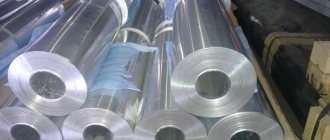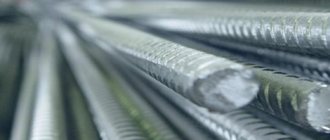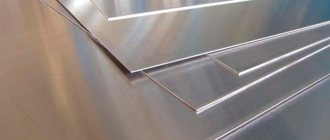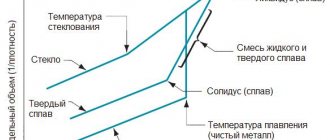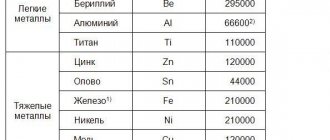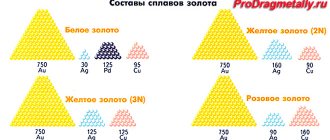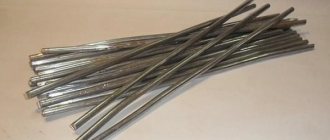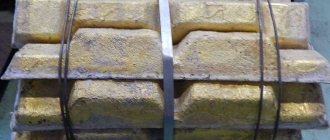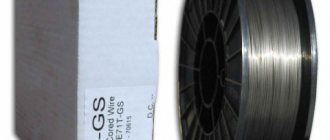Aluminum is a non-ferrous metal with low density. The surface of the alloy is silver-white, matte. It is very light and soft, due to which it has a low melting point - approximately 650 degrees. It has found its application in all spheres of human life. It is actively used in the food industry, including for the manufacture of various tableware. It ranks second in production among all metals in the world, after iron.
Aluminum is susceptible to the aggressive effects of acids. Able to dissolve in concentrated alkali solutions. To avoid such phenomena, all aluminum products are covered with protective films. In a crushed dusty state, being in an oxygen environment, it supports active combustion.
GOST 17151–81. clause 2.3.
Regulates the production of household utensils from sheet aluminum. Utensils must be made from sheets and strips of aluminum grades AD1, AD with a chemical composition in accordance with State Standard 4784, aluminum grades A7. A6. A5, A0 with a chemical composition in accordance with GOST 11069 and bimetallic tapes made of aluminum grades AD1, AD (the composition is regulated by Gosstandart 4784) and steel tape grades 12X18H10T and 08X18N10T with a chemical composition regulated by GOST 5632. If the cookware has an internal coating, it is allowed to make it from sheets and belts made of aluminum alloy brand AMts (composition complies with State Standard 4784). Fasteners that come into contact with food must be made of the same materials as the cookware. The chemical composition of fittings (handles, arms, ears, etc.) made of aluminum must comply with Gosstandart 11069, and those of aluminum alloys - with Gosstandart 4784.
A little about the properties and alloys of aluminum
The thermal and electrical conductivity properties of this metal are comparable to gold, silver and copper. Very common in electrical engineering. Multicore wires and cables are made from it, and windings for electric motors and transformers are created. Aluminum is very ductile, but very fragile. It can be rolled out to a translucent foil. Aluminum ingots can be easily planed and cut. By introducing appropriate additives, the strength of the alloy can be significantly increased, thereby expanding the range of its applications.
A similar alloy was developed in 1911 by German craftsmen in the town of Düren. This is where the name of the alloy consisting of aluminum, copper, magnesium and manganese comes from - duralumin, or duralumin. This combination and long-term hardening made it possible to increase the strength characteristics and maintain the same lightness (aluminum is 3 times lighter than steel). Duralumin alloy has found great use in aircraft construction, due to which it has been nicknamed “winged metal”. To maintain anti-corrosion characteristics, it was coated with pure aluminum.
To eliminate such sputtering, another aluminum alloy with silicon inclusions was developed - silumin. Due to its shine and silvery color, aluminum is used in the production of mirrors, both industrial and technical (for example, for telescopes), and household ones.
Clause 4.3.1
Cutlery must be made from the materials specified in Table 2.
| Product name | Alloy grade | GOST |
| All-metal knives and combination knife blades | Steel U8A, U10A | 1435 |
| All-metal forks and the working part of combined forks | Steel: 08kp, 45 Aluminum alloys: A0, AVM, AD1M AD1, AB, AMg2, AK7, AK5M2, AL22, AL23 | 1050 21 631 4784 1583 |
| Spoons | Aluminum alloys: A0, AVM, AD1M, AD1, AB, AMg2, AK7, AK5M2, AL22, AL23 | 21 631,4784, 1583 |
| Handles of combination knives and forks | Polypropylene grades: 04P-1 010, 05P-1 020 Class B aminoplast Aluminum alloys: A0. AVM, AD1M First grade hardwood lumber with a moisture content of no more than 12 abs. % | Regulatory document 2. 9359 21 631 2695 |
| Fittings for combined products (rings, caps, washers, rivets) | Steel grade 20 Aluminum alloy AD1 | 1050 4784 |
| Note - with the permission of health authorities, it is possible to use other alloys similar to those indicated in Table 2 | ||
Advantages and disadvantages of aluminum cookware
Crockery and cutlery made from this material are present in any modern kitchen. Main advantages of kitchen items:
- good thermal conductivity – pots and pans heat up faster;
- uniform heating of prepared dishes;
- light weight of various kitchen accessories;
- absolute harmlessness to food due to the formation of a special oxide film on their surface;
- Convenient placement of items on shelves in the kitchen.
You can talk about the dangers of dishes made of this metal if they are used incorrectly. For example, if there is no non-stick coating, you cannot cook acidic dishes in it, as this leads to the release of metal into the dishes and to poisoning. See the video below for other shortcomings.
Cutlery
Contact with food products is allowed with primary aluminum grade A or technical deformable grade AD-AD0 (not to be confused with the Al-Mg-Si alloys AD31, AD33, AD35, although forks and spoons are also produced from the AB grade alloy). Gosstandart allows the use of magnesium alloys in AMg2 sheets and AL22 (AMg6l), AL23 (AMg11) ingots, as well as the Al-Mg-Si AB alloy for the production of forks and spoons. GOST 4784 “Aluminum and wrought aluminum alloys. Marki" supplements the permitted list of food alloys below with the following clarification.
Food grade aluminum
The following alloys are used for the production of food grade aluminum:
- AK7, malleable aluminum with a metal content of 87.4 - 93.8% and silicon 6-8%. The alloy is of normal purity, has good mechanical strength and low ductility.
- AK5M2, aluminum-silicon-copper alloy (base content - 85.9-94.05%, silicon - 4-6%, copper - 1.5-3.5%) with normal ductility and high hardness.
- AK9, a silumin alloy for the manufacture of medium-duty parts, can be used for food purposes. Aluminum content 86.94 - 91.63%, silicon 8-10.5%, copper - up to 0.3%.
- AK12, with a base content of 84.3-90%, silicon 10-13%, copper - up to 0.6%. It has high strength and increased density, excellent for complex castings.
- AMg2 can be used in a wide temperature range. Aluminum content is 95.7-98.2%, silicon – up to 0.4%, copper – up to 0.15% and magnesium – up to 2%. As a food alloy, AMg2 aluminum is used in refrigeration equipment, for blanks of strips, sheets, pipes, and plates. It has high ductility and excellent anti-corrosion properties.
Food grade aluminum is a valuable raw material and a reusable product that should be used by humans over and over again.
GOST 4784, clause 3.8
In aluminum alloys that are intended for the manufacture of food products, the proportion of lead should not exceed 0.15%, and the proportion of arsenic - 0.015%. However, GOST 4784 does not indicate the permissible proportion of beryllium and zinc, as GOST 1583 for casting alloys. It is logical that in deformable alloys should not contain lead and beryllium in excess of permissible concentrations, except for AMg5, AMg6, D19, where beryllium is from 0.02% to 0.5% (GOST 1583 allows 0.05%), as well as some brands of welding wire: SvAMG5, Sv1557, SvAMg6, SvAMg61, SvAMg63, where beryllium is from 0.2% to 0.5%.
Is this aluminum accepted for scrap and at what price?
The raw material is not the most expensive type of aluminum scrap, but not the cheapest either. Food-grade aluminum in Moscow is accepted for scrap metal at different prices per 1 kilogram. Ours sets the following cost per kilogram for the following types of scrap:
- Aluminum cans - 30-51 rubles;
- Foil - 45-76 rubles;
- Aluminum containers and utensils - 60-93 rubles.
The final cost of such products is influenced by:
- the degree of purity of the alloy and the presence of impurities present in it;
- volume of collected delivery lot;
- quality and characteristics of the alloy.
The scrap is melted down and reused to make kitchen items, accessories and equipment.
11.31. Aluminum alloys
| Alloys | Chem. elements | DCM, mg/l | Maximum concentrations of chemicals in drinking water, mg/l | Hazard Class |
| Deformable | aluminum (Al) | 0,5 | 2 | |
| —«— | manganese (Mn) | 0,1 | 3 | |
| Deformable | iron (Fe) | 0,3 | ||
| —«— | copper (Cu) | 1, 0 | 3 | |
| Deformable | zinc (Zn) | 1, 0 | 3 | |
| —«— | titanium (Ti) | 0,1 | 3 | |
| Deformable | vanadium(V) | 0,1 | 3 | |
| foundry (GOST 2685) | aluminum (Al) | 0,5 | 2 | |
| —«— | copper (Cu) | 1, 0 | 3 | |
| —«— | silicon (Si) | 10, 0 | 2 | |
| —«— | manganese (Mn) | 0,1 | 3 | |
| —«— | zinc (Zn) | 1, 0 | 3 | |
| —«— | titanium (Ti) | 0,1 | 3 |
Microstructure of unalloyed aluminum
Iron and silicon
Since iron and silicon are the main and obligatory impurity elements, and also since the solubility of iron in solid aluminum is very low, the aluminum-iron and aluminum-iron-silicon phases are visible in the microstructure of all grades of aluminum - except refined, especially pure aluminum. In the cast equilibrium state, the following phases may be present in unalloyed aluminum: FeAl 3, Fe 3 SiAl 12, Fe 2 Si 2 Al 9.
Minor impurities
Minor impurities, such as copper and manganese, are in too small quantities to form their own phases, but can participate in the formation of other phases. To detect them, a high resolution microscope and complex phase identification techniques are required [2].
Certification
The main document remains No. 123−12.328−7 approved by the USSR Ministry of Health dated 7.VIII.79 with additions R. The finishing materials approved by the USSR Ministry of Health are still referred to by SNIP (sanitary norms and rules) for food industry enterprises. The rules provide for obtaining a hygienic certificate for the use of a specific alloy if the alloy complies with RTM 27−72−15−82. What to do if you need to tile a counter or box? It is best to take sheets of grades A or AD, approved by GOST for the manufacture of pots, or apply for a certificate from the sanitary control authorities.
Provider
The supplier "Auremo" offers to buy aluminum alloys for the food industry in bulk or in installments. Large selection of semi-finished products in stock. Optimal price of food grade aluminum from the supplier. Buy food grade aluminum today. We have the best price-quality ratio for the entire range of products. Food-grade aluminum is always available - discounted prices for wholesale customers.
Buy, best price from Auremo
The supplier "Auremo" sells non-ferrous metals on the European market in wholesale and retail quantities. Delivery times take minimal time. You can buy food-grade aluminum from us at the best price. Experienced managers are in touch and will quickly help you buy food-grade aluminum in bulk or in installments. The semi-finished products presented in the warehouse are certified. The price of food grade aluminum depends on the order volume and additional delivery conditions. For wholesale customers, the price of food-grade aluminum is preferential. invites you to buy food grade aluminum. In the segment, non-ferrous metals are a profitable supplier. Buy food grade aluminum today. The best price of food grade aluminum from the supplier.
Introduction to aluminum pans
Not only pots are made from aluminum, but also other kitchen utensils: frying pans, ladles, colanders, ladles, spoons and much more. Even inexperienced housewives distinguish aluminum cookware from steel and cast iron by appearance.
Advantages and disadvantages of aluminum cookware
The list of properties includes both beneficial and harmful ones. Aluminum is not prone to corrosion, is not afraid of temperature changes, scratches, or dents. A huge plus is the lightness of the metal. Thin aluminum pans are very light, which allows you to produce dishes with a volume of 20, 30, 40 liters or more.
Giants are in demand in dining rooms and professional kitchens, as well as in the homes of housewives making home preparations for the winter. Large aluminum pans can be tall or wide. The choice depends on the purpose.
The thermal conductivity of aluminum is higher than that of cast iron and steel, so water boils faster, which is important if you need to boil an egg or cook rice in a bag. The metal is not afraid of contact with flame, so it is suitable not only for gas burners and ovens, but also for open fire. Aluminum camping utensils help out during picnics and fishing.
Contact with aluminum may leave stains on the glass-ceramic hob. There is a way out - use products with an external protective coating. Aluminum pans are not suitable for the microwave . For an induction cooker, there is a ruler with a multi-layer bottom that includes a magnetic disk.
The metal in question is inert to many substances, but actively reacts with some acids and alkalis, and when heated, with salts. Hence the restrictions on prepared dishes and the ban on storing prepared food.
What are aluminum kitchen utensils made of?
For the production of kitchen items, pure food grade aluminum A5 (primary) is used; it is characterized by high thermal conductivity and low heat capacity. The metal itself is quite soft, so alloys with other elements safe for health are also used for pots and pans. According to GOST, these are brands AK7, AK12, AK9, AK5M2.
Aluminum cast iron deserves attention - an alloy that inherits the heat capacity of cast iron and the corrosion resistance of aluminum. Thick-walled stewpans, cauldrons, kettles, and ducklings are made from this alloy. They are lighter than cast iron, but their properties are practically not inferior to them.
For stamping pots, ladles, stewpans, teapots and coffee pots, bimetallic sheets of aluminum and steel . Such products inherit the advantages of two metals. The surface is less porous and not so susceptible to oxidation.
Aluminum reserves on the planet are still encouraging, and its extraction is not very expensive. The metal can be easily formed; production does not require complex expensive equipment. Hence the low price of the products.
What can you cook in pans made of aluminum alloys?
It is not recommended to cook beets, tomatoes, and fish in aluminum pans. You cannot cook food with a high acid content: cabbage soup, berry compotes, jelly, marinades. You should not use an aluminum milk jug to prepare baby food. Here it is better to choose stainless steel.
Aluminum and alloy pans are ideal for cooking pasta, dumplings, dumplings, lean meat, eggs, potatoes, carrots and other neutral, low-acid vegetables.
You cannot store cooked food in aluminum containers. Leftover food should be immediately transferred to storage containers and the pan should be washed. For washing, do not use hard sponges or caustic solutions. If food sticks, soak the dishes in water or boil them.
Nuances of operation
During use, aluminum cookware becomes covered with scale, becomes dull, dark, and rough. It is unlikely that you will want to use the methods of the last century and clean burnt porridge with sand, soda or ammonia. Buy a special product in the store and restore its former shine and cleanliness in a few minutes.
To prevent food from sticking or burning to a forged or cast frying pan, prepare it before using it for the first time using one of the methods described on our website. The new cooking container should be boiled by adding two tablespoons of salt per liter of water to the water.
Is aluminum harmful in the kitchen?
Aluminum has turned from a housewife's favorite into a pariah, due to myths about the dangers of aluminum cookware for health. There are opinions that this metal, entering the body, causes cancer and other irreversible diseases.
However, the ingress of metal particles into food is extremely small, and if you refuse to prepare acidic foods, then it is generally negligible. Pots sold in stores comply with state standards and strict certification requirements, according to which all household aluminum products are covered with special protective films. If you follow the instructions for use and care, there is nothing to be afraid of.
